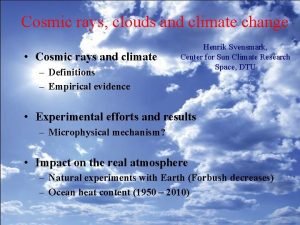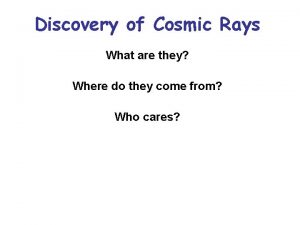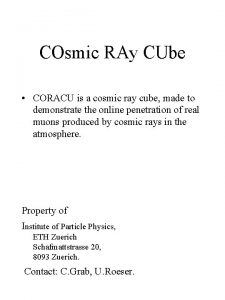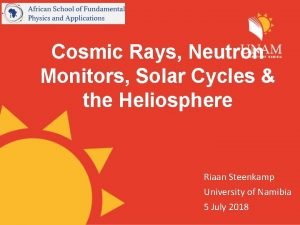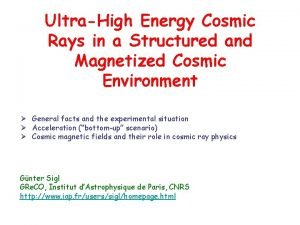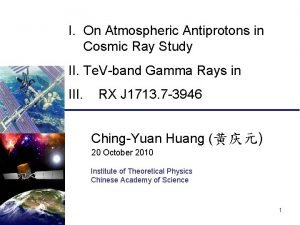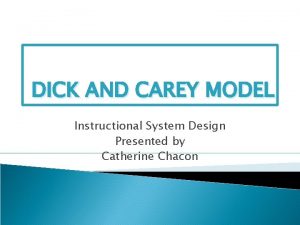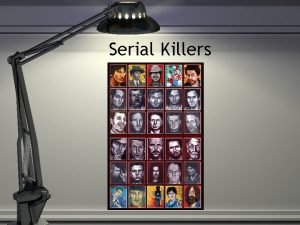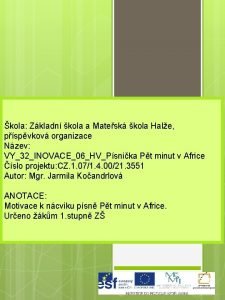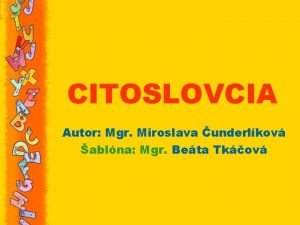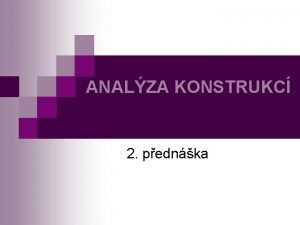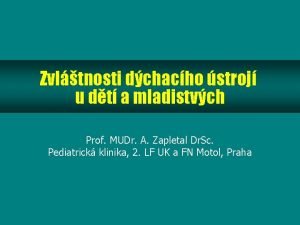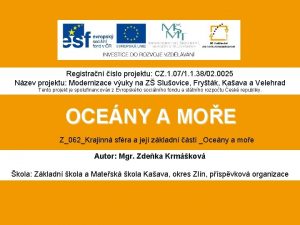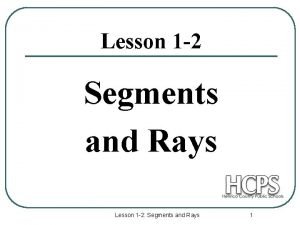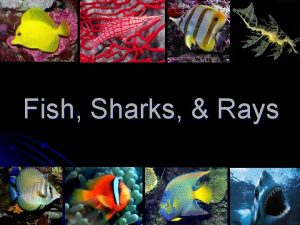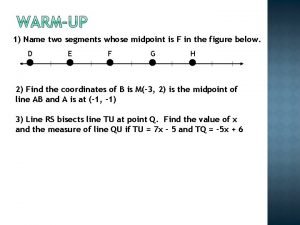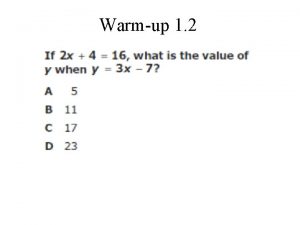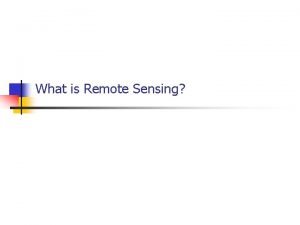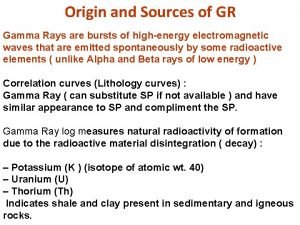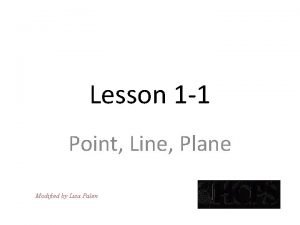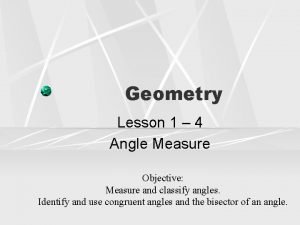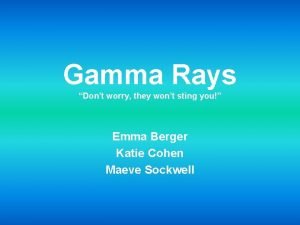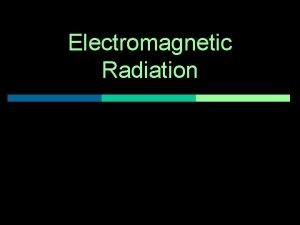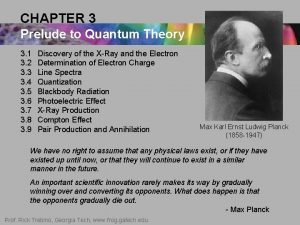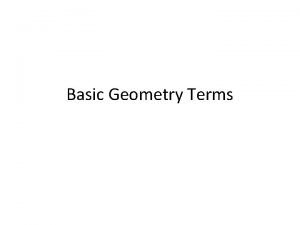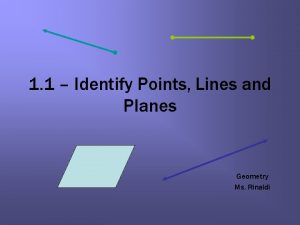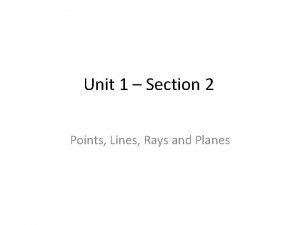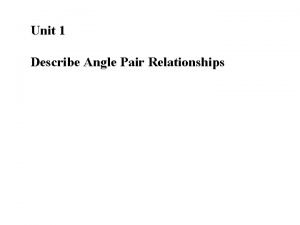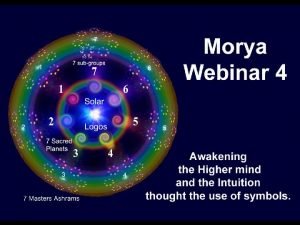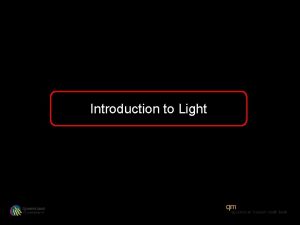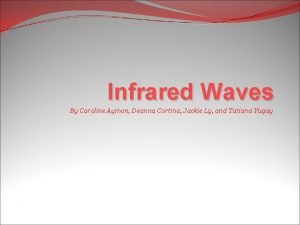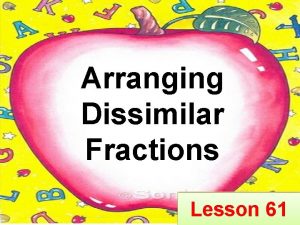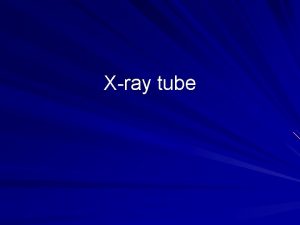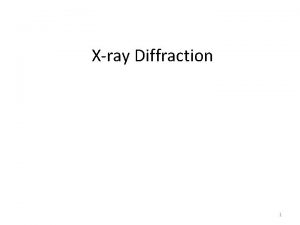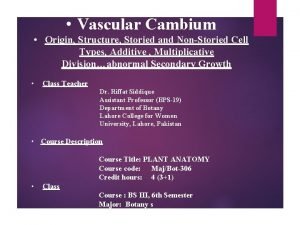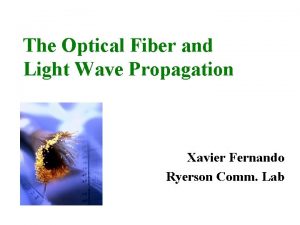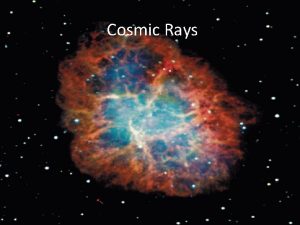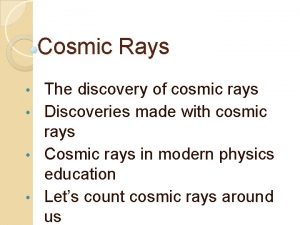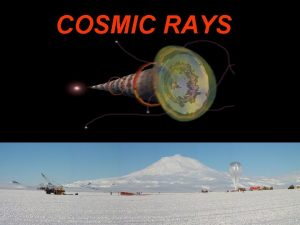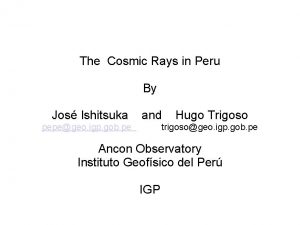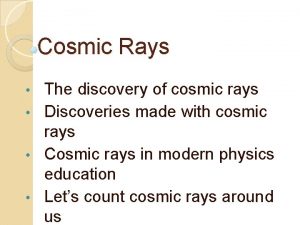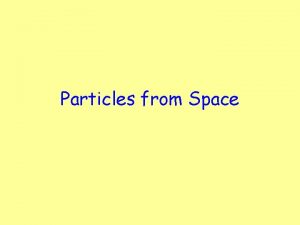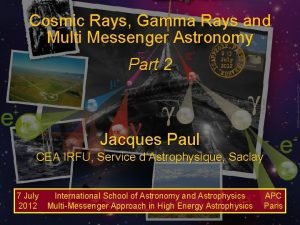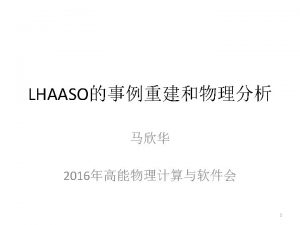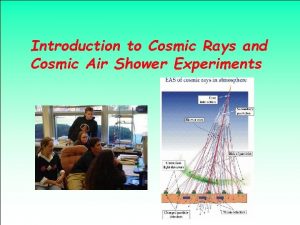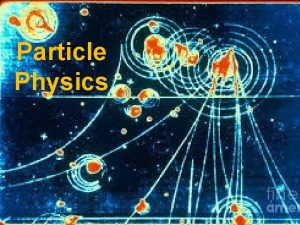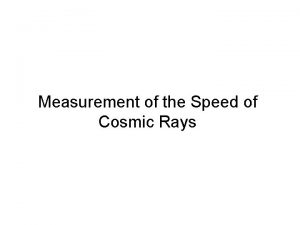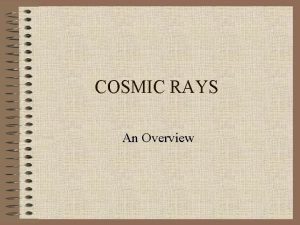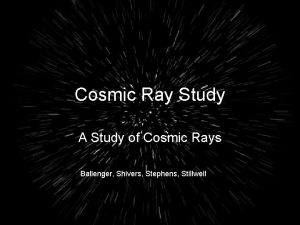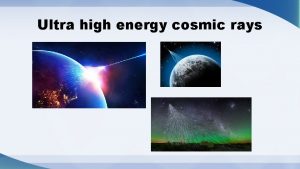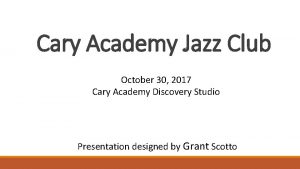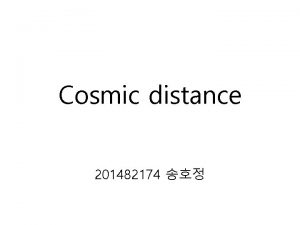Cosmic Rays and Humans in Space Cary Zeitlin




















































- Slides: 52

Cosmic Rays and Humans in Space Cary Zeitlin Southwest Research Institute Boulder, CO

100 Years of Cosmic Ray Physics • Earliest experiments by Wulf, Hess circa 1912. • High-energy physics originated in studies of cosmic rays. • Still a unique window for observing the universe at the highest energy scales.

Applications of Cosmic Rays • An important application of cosmic rays is in biophysics: Prediction and monitoring radiation doses received by astronauts in space from GCR, SPE, SAA passes for Low. Earth Orbit (LEO). • Related subject: Radiation therapy for cancer using similar beams of protons and heavy ions at ~ few hundred Me. V/amu.

Radiotherapy and Space Radiation • Cancer therapy with heavy ions and space radiation have much in common. – Ions and energies of interest are similar. – Intersection of nuclear physics and biology. • A few places - GSI in Germany, NIRS in Japan – have active research programs in both areas.

Cancer Therapy with Charged Particles • Charged particles give • better dose localization than g or X-rays due to Bragg curve. Proton synchrotrons with maximum energies ~ 200 -300 Me. V are used in recent designs.

Proton and Heavy Ion Therapy • Proton therapy gaining acceptance: Loma Linda University, Mass. General, MD Anderson, etc. – More coming online in the next few years. • Heavy ion therapy initially done at LBL in 1980’s & 1990’s, dropped (no funding) , picked up in Japan, Germany, and elsewhere in Europe. – No facilities presently in US, nor are any planned. • Efficacy of charged particle therapy vs. conventional still has doubters but the physics makes sense.

Heavy Ion Therapy Advantages From Schardt et al. • Even better dose localization – ions have higher • • peak-to-entrance plateau ionization ratio. LBL did only salvage cases low success rate, but GSI & HIMAC have shown clinical success. US lagging – regulatory hurdles.

Heavy Ion Therapy Disadvantages • Distal edge due to fragmentation slightly reduces dose localization benefits. • Machines are expensive. – Costs coming down, may soon be competitive with proton accelerators. • Lack of FDA approval.

Heavy Ions in Space • Same types of particles used to treat cancer may also induce it, even at low doses. • Long-duration spaceflight increases risk of cancer, cataracts, maybe CNS damage. – Earlier onset of cataracts seen in astronaut cohort. – No experience with long-duration flight outside LEO.

Radiation Exposures in Space • Complicated exposures – GCR gives a mix of particles & energies. – Huge unknowns in the biology. – Some unknowns in the physics. • Some of the exposure can be due to Solar Particle Events (mostly protons). – Modest shielding prevents acute effects, even in intense events. • In LEO, also get dose from passes through SAA (trapped protons).

Exposure to GCR • Dose mostly from protons and heavier ions, with • • energy in the 10’s of Me. V/nuc to ~ 10 Ge. V/nuc. Health physics: Dose equivalent is the measure of risk for cancer induction. Conventional wisdom: 1 Sv 3% increase in fatal cancer risk. – Based largely on Japanese A-bomb survivors. • Hard to estimate doses retrospectively. – 3% is also the US legal maximum for job-related health hazards.

Uncertainties in Risk Projections 10% Maximum Acceptable Risk = 3% ▲ 1% ISS Mission 0. 1% . 01% Lunar ▲ ▲ ▲ Shuttle Mission Increase in Individual’s Risk of Fatal Cancer Mars Mission

Uncertainties in Risk Projections 10% Maximum Acceptable Risk = 3% ▲ 1% ISS Mission 0. 1% . 01% Lunar ▲ ▲ SPE? ? “ 95% Confidence Interval” ▲ Shuttle Mission Increase in Individual’s Risk of Fatal Cancer Mars Mission

Cosmic Ray Spectra • GCR ~ 90% protons • Most of the rest is He. • Electrons and heavy • ions (Z > 2) are 1 -2% of the total flux. But contributions to dose go as Z 2…

Abundance of Galactic Cosmic Rays by Species in Unshielded Deep Space Badhwar- O’Neill Model

Abundance weighted by <LET>

Abundance weighted by average dose equivalent Fe is the tallest pole!

What is Dose Equivalent? • Unit of dose is Gy = 1 J/kg. Purely physics. • Unit of dose equivalent is Sv, same units, but • with a weighting factor that varies by radiation type to approximate biological effectiveness. For exposure to a single radiation type, the specific radiation weighting factor is used, w. R. – w. R = 1 for g, e-, m; 5 for protons; 20 for a and heavier nuclei. • For a mixed field, one integrates the “LET” spectrum (LET = d. E/dx in water) vs. a “quality factor” which depends only on LET, Q(L).

Mixed-field Quality Factor Q(L) • Traditional view: effects increase to ~ 100 ke. V/mm, and then decline due to “overkill. ” – Can’t kill a cell more than once. (Dead cells aren’t really the problem anyway. ) • Huge scatter in the RBE data. – Lots of questions: what is (are) the right endpoint(s)? – Can we extrapolate cells or small animals to humans? Figure courtesy of F. Cucinotta, JSC

Nuclear Fragmentation • N-N collisions fragmentation of heavy ions into lighter ions. • “Projectile fragments” ~ preserve b and direction of incoming ion. • “Target fragments” are Me. V’ish – Charged particles are short-ranged. – Neutrons with high w. R are produced. • For total dose, fragmentation helps: – d. E/dx ~ Si Zi 2 and sum of squares < the square of the sum. – Effect on dose equivalent not so easy to characterize.

Transport Calculations • Analytic and Monte Carlo approaches. • NASA codes date to 1960’s, when MC was impractical due to CPU limitations. • Analytic solves the Boltzmann equation with many approximations and less realism, e. g. , problem is reduced to 1 -d. • Either way, need knowledge of many nuclear fragmentation cross sections.

Cross Sections and Transport J. Wilson et al. , NASA TP, 1995 Z. Lin, Phys Rev C 75, 2007 Fragment production cross sections Chargechanging cross sections

Nuclear Cross Section Database • Or, “What can a 3 -person group do with a tabletop experiment using 80’s technology? ” • Turns out there is (or was) a niche: Most cross sections needed for transport models not measured (& never will be). – # of exclusive final states is ~ intractable. – Inclusive reactions to be studied are of the form (Zp, Ap) + (Zt, At) (Zf, Af) + X • Small subset of possible reactions was used to “validate” models (30 -50% errors o. k. ).

Experimental Program • • Measure as many cross sections as possible. Silicon detectors upstream & downstream of target. Main issues are dynamic range of readout electronics – need 3 orders of magnitude – and availability of beams. Unlike earlier experiments, use small-acceptance detectors to measure light fragments.

Large & Small Acceptance Spectra • Upper histogram is typical for • • this type of experiment – resolve fragments down to Zfrag ~ Zbeam/2. Previously, cross sections only reported for these “peripheral” interactions. Rough analogy to deep inelastic scattering: if we only test Zfrag Zbeam/2, we’re not going very “deep. ”

Experimental Database Ion 56 Fe Energy (Me. V/nuc) 400 500 600 48 Ti 40 Ar 800 1000 3000 5000 1000 290 400 35 Cl 28 Si • Accumulated over 12 650 290 24 Mg 400 • 650 600 1000 800 1200 3000 5000 10000 400 20 Ne 290 400 600 16 O 290 400 600 14 N 290 400 12 C 290 400 11 B 290 400 10 B 290 400 4 He 230 • 1000 3000 5000 10000 years of ~ 1 week/yr of beam time. For each beam ion/ energy, full target set was C, CH 2, Al, Cu, Sn, and Pb. ~ 200 chargechanging cross sections, ~ 2000 fragment production cross sections measured.

Fragmentation Data vs. Models • Simple model of overlapping • • spheres describes chargechanging s’s to ~ 5 -10%. Older parametric models predict monotonically decreasing fragment production cross sections as a function of DZ. Missing physics: – Odd/even effect – Suppression of Z=9 – Increased cross sections for CNO. • PHITS & FLUKA use different flavors of QMD and do much better than older models, but still off.

Shielding Effectiveness: Another Way to Look at the Same Data • 1 Ge. V/amu 56 Fe beam with many • materials, including spacecraft shielding candidates. Nobody has a metric of shielding performance, so we made one up based on physics (not biology). – d. Dn = change in avg. dose per particle behind the target. • Take out depth effects, get unsurprising result: hydrogen best. – Fragmentation drives dose reduction. – Mass ~ A, s ~ A 2/3, so as A increases the # of interactions per unit target mass goes down. • Predicted by Wilson et al. for GCR, nice to validate in lab.

Beam Dependence of Shielding Results • Wilson calculated for GCR. • Are the experimental results beam-dependent? – Can a single beam/energy serve as proxy for the GCR? • Looked at dose reduction with • the same CH 2 target in several different beams. It seems any energetic heavy ion beam of Z 14 and E 600 Me. V/amu or greater yields ~ similar results.

TEPC Characterization • Experiments with T. Borak (CSU) • to characterize response of tissue-equivalent proportional counters to heavy ions. Simple device with complicated response function. – – – Widely used in health physics. Used by NASA on ISS, Shuttle. Response not systematically studied. • TEPCs measure “lineal” energy • transfer, typically equated to LET (but not rigorously correct). Avg. energy deposited vs. impact parameter looks strange…

Tissue Equivalent Proportional Counters • For these experiments, used spherical TEPC with field-shaping helical wire surrounding anode. • Tissue equivalent wall - wall effects crucial. • Fill with TE gas @ ~ 100 millitorr to simulate a 1 mm diameter tissue volume. • Helical wire causes artifacts, too – Flight TEPCs are cylindrical, no wire. • Result shown on previous slide (e vs. b) greeted with scorn by “experts” at first.

Modeling Explains Measurement • Proposed mechanism for • • GEANT 4 simulations by Taddei, Zhang, and Borak “boomers” – ionization cloud formed in wall near cavity boundary leaks in. First good model calculation by Nikjoo agreed with the data. Later modeling by Taddei et al. using GEANT 4 supports conclusion.

Flight Measurements • Impossible to measure all particles of interest – • many trades to make a flight instrument. Typical allocation for a NASA ESMD instrument: few kg of mass, a few W of power, a few $M. – Hitch a ride on an interplanetary mission (MARIE on Mars Odyssey, RAD for MSL, CRa. TER on LRO), or to ISS. • NASA JSC has operational responsibility for crew dose monitoring – they rely on TEPC, passive dosimeters, and some data from international partners. – JSC particle spectrometers flown to date on ISS, Shuttle had lots of problems.

MARIE • Martian Radiation Environment Experiment flew on 2001 Mars Odyssey spacecraft. – Original plan: Odyssey was orbiter + lander. Idea was to have an instrument on both. – After MPL crashed, NASA got cold feet & Odyssey became an orbiter only. (Lander became Phoenix. ) • Straightforward silicon telescope built by NASAJSC, similar to ISS instruments. – – Worked for 20 months, failed in Halloween ’ 03 SPE. Many hardware & firmware problems.

CRa. TER (Cosmic Ray Telescope for the Effects of Radiation) • Built by Spence et al. , • • Boston University. Si telescope with alternating pairs of detectors and pieces of tissue-equivalent plastic. Will fly on Lunar Reconnaissance Orbiter (LRO), launch scheduled for May.

Mars Science Laboratory (MSL) • MSL is the largest Mars rover to date – 850 kg, 10 instruments • Launch date – Fall 2011 • • (was to be Fall ’ 09). Arrives at Mars between July & September 2012. Prime mission duration 1 Mars year (687 days)

RAD for MSL • • • Kiel University built sensor head, Sw. RI built electronics. 1. 5 kg, 4 W ~ 104 dynamic range in DE for charged particles: Si telescope (A+B+C) & Cs. I(Tl) (D). n Cs. I stops protons up to ~ 100 Me. V (good for SEPs). Plastic scintillator (E) for neutrons with energy > 10 Me. V. – Large neutron flux from RTG at lower energy. • Plastic scintillator anticoincidence shield (F).

MSL RAD Scintillators • Scintillators read out Cs. I (D) by photodiodes. D Readout Diode CSA – Keeps mass down. – Only one bias voltage ( -70 V) needed, no risk of coronal discharge. – Anticoincidence also read out by photodiodes. Retainer Neutron Channel (E) E Readout Diode

RAD Electronics • Preamplifiers & 1 st-stage shaping amps built into • • • sensor head. Analog outputs electronics box, into VIRENA (36 -channel custom ASIC). VIRENA multiplexes outputs for the 14 -bit ADC. Digitized data processed in Level 3 by a virtual 8051 instantiated in the RDE FPGA. – Most events histogrammed, a few high-priority (high LET) events will be telemetered down. – Only sending down ~ 400 k. B/day.

VIRENA ASIC • Built by NOVA R&D. • Fast & slow discriminators, additional shaping stage, • • • sample & hold, output multiplexer. Highly configurable. Controlled by the “RAE” FPGA which runs Level 1 software for trigger & readout control. Same FPGA runs Level 2 software (uses digitzed data) for low-level data processing – applies calibration constants, chooses best gain readout, etc.

Beamline Setup for Calibration target Beam incident from left. Some beam ions survive the target, others fragment into lighter ions. (Just like fragmentation experiments. ) Need to calibrate quenching, esp. in E, for heavy charged particles.

Species Resolution in Si Detectors Scale PH to ion charge

RAD for ISS • Charged particle capability ~ same as MSL RAD. – Slightly enhanced – Cs. I replaced by larger BGO for more stopping & to eliminate possible issue with moisture. (ISS can get humid. ) • Greatly enhanced neutron capability. • Neutrons are created by nuclear interactions. – Important behind large depths of shielding. – Estimated to contribute 30 -50% of dose equivalent in ISS. – ISS shielding highly variable, averages 20 g cm-2.

Neutron Coverage • MSL RAD not designed • for lower energies because of RTG. ISS RAD will be used for crew dosimetry, must measure 0. 5 -10 Me. V neutrons.

Neutron Coverage • MSL RAD not designed • for lower energies because of RTG. ISS RAD will be used for crew dosimetry, must measure 0. 5 -10 Me. V neutrons. MSL RAD

Neutron Coverage • MSL RAD not designed • for lower energies because of RTG. ISS RAD will be used for crew dosimetry, must measure 0. 5 -10 Me. V neutrons. ISS RAD MSL RAD

Adding Neutron Spectrometry to RAD • Plan: Use boron-loaded plastic scintillator (Bicron • • • BC-454 or Eljen EJ-254) and capture-gating. Unique signature of capture events: first pulse from interaction(s) with protons, neutron is thermalized, captured by 10 B. Amplitude of 1 st pulse neutron energy no unfolding. Second pulse is due to 10 B (n, a)7 Li* reaction. – About 2. 3 Me. V released, but light output is heavily quenched 60 ke. Vee. – Dt distribution is exponential, <t> ~ 2 msec for usual B concentration.

B-Loaded Plastics in Flight Experiments • Double-pulse method used by instruments built for planetary science: – Mars Odyssey Neutron Spectrometer (LANL). – Mercury Messenger Gamma-Ray and Neutron Spectrometer (JHU APL). • Both use PMT’s for readout. • GRNS uses scanning ADC with FPGA doing all the coincidence logic.

Capture Gating • Can’t see 2 nd pulse above noise with pin diodes – noise is 1 Me. Vee FWHM at best. • Investigating APD’s + optimized preamp design. – Present preamp excellent for low-capacitance detectors; APD’s are high-capacitance. – Have to add ~ 400 V HVPS. – Fallbacks are Si. PM’s and (worst case) PMT since constraints are greatly relaxed for ISS.

Conclusions • Space radiation health presents many challenges – small but important role for physics.

Conclusions • Space radiation health presents many challenges – small but important role for physics. • Severely resource constrained, but that’s part of what makes it a challenge.

Conclusions • Space radiation health presents many challenges – small but important role for physics. • Severely resource constrained, but that’s part of the challenge. • Thanks for your attention!
 Cosmic rays and clouds
Cosmic rays and clouds Cosmic rays discoverer
Cosmic rays discoverer Coracu
Coracu Cosmic rays
Cosmic rays Cosmic rays
Cosmic rays Cosmic waves
Cosmic waves Dick and carrey
Dick and carrey Carey stainer
Carey stainer Poletime do afriky text
Poletime do afriky text Citoslovcia delenie
Citoslovcia delenie Cary high school website
Cary high school website Cary christian student death
Cary christian student death Cary duffy
Cary duffy Příčinkové čáry
Příčinkové čáry A legend of the northland phoebe cary
A legend of the northland phoebe cary Poklep plic
Poklep plic Zúžená část oceánů (moří) se nazývá
Zúžená část oceánů (moří) se nazývá Homework app
Homework app Congruent segments definition geometry
Congruent segments definition geometry Lesson 2 segments and rays
Lesson 2 segments and rays What does shark skin feel like
What does shark skin feel like Opposite rays example
Opposite rays example Direct and indirect rays of the sun
Direct and indirect rays of the sun Lesson 1-3 segments rays parallel lines and planes
Lesson 1-3 segments rays parallel lines and planes Unscented trajectory chapter 5
Unscented trajectory chapter 5 Space junk the space age began
Space junk the space age began Camera space to world space
Camera space to world space Unscented trajectory chapter 5
Unscented trajectory chapter 5 Ndc to screen space
Ndc to screen space Limitations of remote sensing
Limitations of remote sensing Origin of gamma rays
Origin of gamma rays Name all the rays
Name all the rays Opposite ray geometry
Opposite ray geometry And his tune is heard on the distant hill
And his tune is heard on the distant hill Things that blocks light
Things that blocks light What is a renal lobule
What is a renal lobule Name the angle
Name the angle Maeve sockwell
Maeve sockwell Gamma rays uses
Gamma rays uses N-rays
N-rays 2 rays that meet at an endpoint
2 rays that meet at an endpoint Example of opposite rays
Example of opposite rays Lines ab and cg are
Lines ab and cg are Linear pair relationship
Linear pair relationship 7 rays
7 rays Introduction of light reflection and refraction
Introduction of light reflection and refraction Infrared uses and applications
Infrared uses and applications Ano ang fraction na nasa pagitan ng 1/6 at 1/3
Ano ang fraction na nasa pagitan ng 1/6 at 1/3 Modern x ray tube
Modern x ray tube Origin of x rays
Origin of x rays Cerebral venous thrombosis ppt
Cerebral venous thrombosis ppt Material dispersion
Material dispersion Tangent rays of the sun
Tangent rays of the sun
